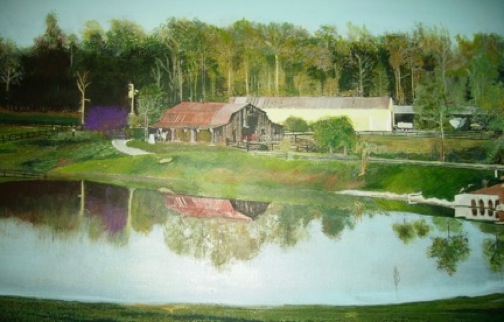-
not about bird cams… something better!
Here’s a picture (actually a painting I did several years ago) of the back 40 of the equestrian center where I work part-time. It’s situated on 400 acres, about one hour northwest of Atlanta. As you can very well imagine, it’s prime wildlife habitat. We have some good-and not so good inhabitants. The latter is being inundated with house sparrows, and several coyotes driven there by development.
This blog was supposed to be on bird cams, and I sure do wish we had a few of them scattered around the place! Today there was an amazing occurrence and I missed it, missed it I tell ya… a once in a lifetime opportunity!
A boarder was grazing her horse near this very pond earlier today. She in fact phoned me on the way home to tell me what had happened. By the tone in her voice I could tell it was something out of the ordinary… “a Bald Eagle” she said. It had been spotted stealing eggs from a nest. “Huge” she said, with a wingspan wider than the length of her horse. She said the bright white head was unmistakable, and it must have been raiding a crow’s nest as several were trying to dive-bomb and chase him away, still carefully keeping a distance.
We can only hope this Bald Eagle thinks the diggs are pretty decent around here, and decides to take up permanent residence at Moonlight Stables. Sorry there’s no photo… we’ll definitely be on the look-out though!
-
Recycled Finch Feeders for Earth Day & Always
Happy 41st Birthday Earth Day!
Recycle and Reuse… that’s the deal to minimize your carbon footprint. In all facets of life-including backyard birding, there so many recycled products from which to choose. Recycled plastic finch feeders, and every other kind of feeder and birdhouse seriously help to keep plastics out of our landfills.
A recycled bluebird feeder I purchased a few years ago came with a sticker saying how many plastic jugs were used to make this item. It wasn’t a “stock” sticker either, because the number 33 was hand written on it. Besides that… the feeder still looks brand new after three years!
These new recycled finch feeders are pretty cool too as they feature “all-over” feeding space. Unlike traditional tube feeders that have perches, these finch feeders have something called “magnet mesh” which is very attractive to clinging birds such as finches.
Consider making your next finch feeder, oriole feeder, bluebird or woodpecker feeder a recycled plastic one. The non-porous surface is easier to clean and minimizes mold and bacterial growth. They won’t warp, crack, split or fade, and it’s likely the feeder (or house) will still look new after several years of use. Recycled is a wise investment and saves money in the long run because the product lasts!
-
America’s Wild Horses May Finally Have Their Day in Court
Federal Court Gives Green Light To Wild Horse Lawsuit
District Judge Rejects Interior Dept. Motion to Dismiss CaseSacramento, Calif. (April 20, 2011) – In a precedent-setting decision, issued today in the United States District Court, Eastern District of California, Judge Morrison C. England, Jr. rejected the U.S. Department of Interior’s motion to dismiss a lawsuit challenging the roundup and removal of nearly 1,579 wild horses and 159 burros from the Twin Peaks Herd Management Area (HMA) in northeastern California last year.
Judge England also ruled that the plaintiffs – animal protection organization In Defense of Animals (IDA), ecologist Chad Hanson, Ph.D., wild horse sanctuary founder Barbara Clarke, DreamCatcher Wild Horse and Burro Sanctuary, local resident and wild horse enthusiast Linda Hay – have standing to challenge the action and that the case is not moot, despite the fact that the roundup has already taken place. In past wild horse roundup litigation, courts have dismissed claims as moot because the roundups had already concluded, never ruling on the merits on the case.
However, In Defense of Animals et al. vs. Interior Department et al., headed by pro bono legal counsel Rachel Fazio, outlines specific remedies and the ongoing harm plaintiffs suffer from Twin Peaks mustangs being held in captivity in government long-term holding facilities – facilities that the plaintiffs allege are illegal. Fazio argued in her briefs that the case was not moot, in part because the Interior Department could return captured horses to the range.
“The American Mustang is a native wildlife species; few people realize that the western United States is actually the evolutionary birthplace of the horse,” said Rachel Fazio, legal counsel for plaintiffs. “This suit seeks to ensure that, in accordance with the laws of Congress, this majestic species is protected as wild and free-roaming, safe from illegal interference by the BLM and immune to the pressures of the livestock industry and other commercial interests that wish to exploit our public lands.”
Plaintiffs in the litigation include ecologist Dr. Chad Hanson, a researcher at the University of California at Davis and author of numerous scientific studies, Barbara Clarke, wild horse expert and director of the 2,000-acre DreamCatcher Wild Horse and Burro Sanctuary in Northeastern California, the DreamCatcher Wild Horse and Burro Sanctuary itself, ecologist Dr. Chad Hanson, Linda Hay, a local resident who has visited and enjoyed the Twin Peaks horses for the past thirty years, and animal protection organization In Defense of Animals.
“We may finally have a court address the merits of a case challenging wild horse roundups and not dismiss it on technicalities,” said Eric Kleiman, Research Director for In Defense of Animals. “This is a groundbreaking legal decision that could lead to America’s wild horses finally having their day in court.”
In addition, the plaintiffs have appealed to the Ninth Circuit Court of Appeals Judge England’s denial last year of a preliminary injunction to halt the Twin Peaks roundup. The remedy of returning horses to the range was also a critical issue of discussion at a hearing before the Ninth Circuit in San Francisco earlier this year.
Meanwhile, Twin Peaks horses have been scattered across the country at Interior Department’s Bureau of Land Management (BLM) holding facilities, and untold numbers have perished while in captivity.
Plaintiffs have revisited the Twin Peaks area and report difficulty locating wild horses to view in the aftermath of the roundup.
Between August and September 2010 – the hottest months of the year – the BLM removed 1,579 wild horses and 159 burros from the HMA. The roundup was a devastating blow to California’s wild horse and burro population, removing more than one-third of California’s entire mustang and burro population which is estimated to be only approximately 5,000 throughout the entire state. The Twin Peaks HMA encompasses 798,000 acres of public land, yet the BLM allows just 448 to 758 wild horses and 72 to 116 burros to reside in the area. Meanwhile, the agency authorizes up to four times more cattle and nearly seven times more sheep to graze this federally-designated wild horse and burro habitat.
Wild horses comprise a small fraction of grazing animals on public lands, where they are outnumbered by livestock nearly 50 to 1. The BLM has recently increased cattle grazing allotments in areas where wild horses are being removed. Currently the BLM manages more than 245 million acres of public lands of which cattle grazing is allowed on 160 million acres; wild horses are only allowed on 26.6 million acres this land, which must be shared with cattle. The Obama Administration has accelerated the removal of wild horses and burros from public lands in the past year, while Congress just last week approved funding for yet more BLM roundups beginning this July. There are currently more than 36,000 wild horses warehoused in government holding facilities and only 33,000 wild horses free on the range.
In Defense of Animals is an international animal protection organization located in San Rafael, Calif. dedicated to protecting animals’ rights, welfare, and habitat through education, outreach, and our hands-on rescue facilities in Mumbai, India, Cameroon, Africa, and rural Mississippi. For more information, visit www.idausa.org.



